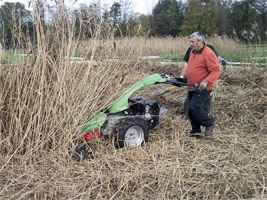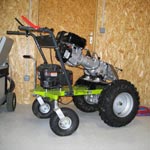Reed cutting in constructed wetland plants
 Reed cutting in the treatment plants of Negrepelisse (4000PE) and of Saint Etienne-de-Tulmont (1900 PE)
Reed cutting in the treatment plants of Negrepelisse (4000PE) and of Saint Etienne-de-Tulmont (1900 PE)
The reed cutting in constructed wetland plants consists in cutting the faded reeds at 30/40 cm from the ground and taking them out of the filters. This avoids the reeds accumulation and also reduces the mud’s thickness on the filters’ surface. Usually the reed cutting is handmade and done during November and a little after the reeds fading.
To reduce the hardness of this task and to save time, the Communauté de Communes Terrasses et Vallée de l’Aveyron in association of Adour Garonne Water Agency, and for three years, leads a reflection on the reed cutting mechanization.
During the reed cutting in November 2011, in the plants of Negrepelisse and of Saint Etienne-de-Tulmont, three machines were tested for the cutting, the conditioning, and the transport of the reeds. This operation started on the November 15th and was finished on the 1st of December. If it had been manmade, fifty four days would have been necessary for the reed cutting of the two plants. The following tabular form presents the time passed on each plant and the quantity of removed reeds.
| Saint Etienne de Tulmont | Nègrepelisse | |
|---|---|---|
| Days of works if manmade | 14 | 40 |
| Reed cutting, pressing and evacuation | 10 | 30 |
| Finishings (raking) | 4 | 10 |
| Numbers of bales | 265 | 780 |
| Filter surface (m²) | 3600 | 8000 |
| Reeds mass estimation (tonne) | 3,2 | 9,36 |
| Density per hectare (t/ha) | 8,9 | 11,7 |
This first try underlines several solutions to improve the cutting technique and the reeds extraction. The goal of this process is the elaboration of technical specifications and of the creation of a machine specialized in reed cutting in constructed wetlands.

Poor countries sanitation
The constructed wetlands are well adapted to the countries with little technical skills.
Read the file